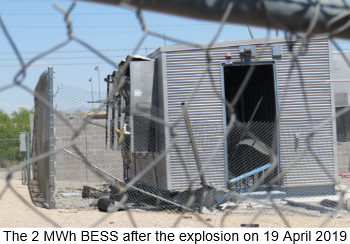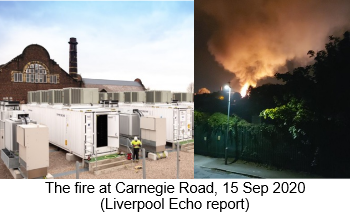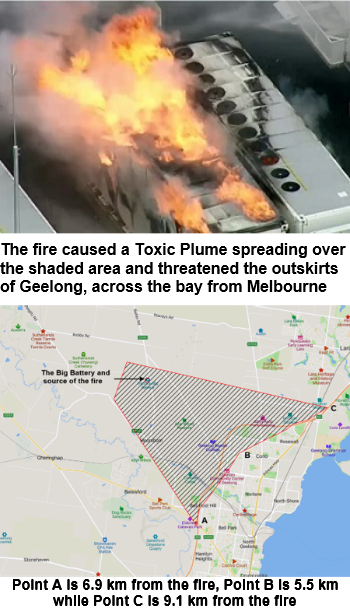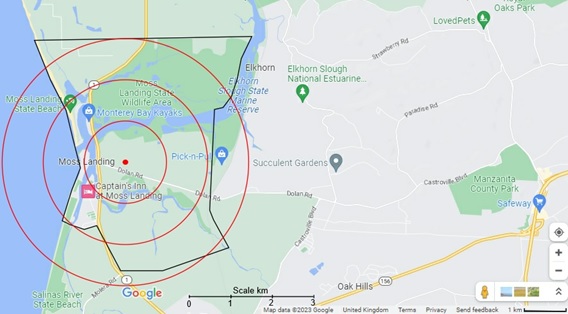
RECENT BESS FIRES
The development of battery energy storage systems over the past 10 years has been characterised by the frequency of spontaneous fires. In Korea there have been 30 BESS fires since 2017, so many that the Korean authorities imposed a moratorium on building BESS until the causes were investigated. It was found that some BESS fires occurred in coastal areas with higher humidity, which may be a point to raise regarding the siting at Coldharbour.
The Fordham-Allison-Melville paper describes many incidences of recent battery fires, and examples are described below. The paper explains how fires can propagate, often from deep inside the system. Battery fires can seemingly be brought under control, but then flare up again the following day. Their paper identifies well-established hazards of large-scale Lithium-ion Battery energy Storage Systems and reviews authoritative accounts and analyses of incidents that have arisen from them.
The Lithium-ion batteries used in these battery storage systems can fail by "thermal runaway" where overheating in a single faulty cell can propagate to neighbouring cells and the energy released resultsc in what is popularly known as a "battery fire".
These are not strictly "fires" at all, requiring no oxygen to propagate. They are uncontrollable except by extravagant water cooling. Lithium itself is a highly reactive element like Sodium or Potassium. It reacts with water giving off Hydrogen gas.
As well as Hydrogen, battery fires also evolve toxic gases such as Hydrogen Fluoride (HF) and highly inflammable gases including, Methane (CH4), Ethylene (C2H4) and Carbon Monoxide (CO). These in turn may cause further explosions or fires upon ignition. The chemical energy then released can be up to 20 times the stored electrochemical energy.
The following are recent examples of Battery fires.
Arizona 2019

In 2019 a 2MW/2MWh facility in Arizona took 2 hours to bring under control but the resulting explosion of Hydrogen and Carbon monoxide mixing with air critically injured 4 fire fighters.
Two fire-fighters suffered life-limiting brain injuries, one suffered spinal damage and fourth facial lacerations.
Liverpool 2020
In 2020 a 20MW/10MWh Battery Energy Storage System in Liverpool developed a short circuit and caught fire. It took 11 hours to put out the fire with copious amounts of water.

The composite picture above shows a photograph of the site before the explosion and a photograph of the conflagration which ensued. (Photographs courtesy of the Liverpool Echo)
A further account of this is given in a report to the Faversham Society by Professor Sir David Melville who concludes
'It transpires that even for the Liverpool incident in a relatively small BESS, the fire suppression measures were ineffective, the Fire and Rescue Service were inadequately informed and prepared, and a serious fire and large explosion took place which could have resulted in serious injury or death'.
Sir David Melville also points out that water and Hydrogen Fluoride gas combined together to form Hydrofluoric acid which is extremely corrosive and can dissolve concrete.
Houston Texas 2021
In 2021 in Houston, Texas, a driverless Tesla Model S crashed and the battery ignited. It took 4 hours and 30,000 US gallons of water to control this fire.
Moorabool, Victoria Australia 2021

The Victoria Big Battery 300MW/450MWh project was commissioned in at Geelong, Australia in late 2021. The State of Victoria had extolled their big battery on their website, and a question was asked of its safety. Their reply was:
"While grid scale batteries are relatively new, lithium battery technology is proven and has an excellent safety record. The battery will be located away from residential areas and will be required to comply with strict fire and electrical safety regulations".
Construction started in early 2021, but in July, during initial testing one of the 212 Tesla Megapack containers caught fire.
The conflagration was so fierce that the adjacent container was destroyed and a further one was scorched. 150 fire fighters were on the scene and the decision was taken to let the fire burn itself out.
Crews wearing breathing apparatus worked to try to contain the fire and stop it spreading to nearby batteries. The Country Fire Authority decided to let the fire burn out and concentrate on protecting other module while the fire burned for over three days.
A Fire and Rescue Victoria (FRV) HAZMAT appliance was on scene conducting atmospheric monitoring with a Scientific Officer in support. FRV's specialist Remote Piloted Aircraft System (RPAS) unit was deployed.
There was considerable amount of toxic smoke and residents in the path of the prevailing wind were advised to close windows, stay indoors and keep animals indoors. The area closed down is represented by the hatched area in the figure below.
It can be seen that the prevailing wind from the North West directed the smoke towards the town of Geelong which is situated across the bay from Melbourne. The area of toxicity covered 30 km2 in a broad swathe off centred from the source of the blaze. The limits of the area 9.1 and 5.5 km from the fire.
Emergency services issued a warning for toxic smoke in the nearby Batesford, Bell Post Hill, Lovely Banks and Moorabool areas. (Some of these places are between 6.9 and 9.1 km (up to 6 miles) from the battery. Residents were warned to move indoors, close windows, vents and fireplace flues and bring their pets inside. The cause of the fire was attributed to a leak in the cooling system, which caused a short circuit
.Beijing 2021
Another battery fire in 2021 occurred in Beijing when an explosion occurred when a fire developed in a 25 MWh lithium-ion phosphate battery connected to a rooftop solar panel installation. Sadly, two firefighters were killed and and a first responder, not a firefire is still missing (See Beijing Fire )
The First Moss Landing Incident, California 2021
Vistra's BESS at Moss Landing sustained an emergency shutdown on 4th September, when some of its battery packs overheated and threatened to catch fire. (See the first Moss Landing incident)
The overheated batteries didn't catch fire but did fill the building with smoke. Fire officials with Monterey County said that the system's fire suppression systems worked perfectly, and there was no threat to the public. A further report gave that a dry bearing in one of the pumps produced smoke which triggered the smoke detectors. These in their turn initiated water sprinklers which playing on the electronics began to cause short circuiting and overheating. The overheating caused plastics and wiring to melt but the lithium-ion batteries (fortunately) did not catch fire.
The Second Moss Landing Incident, California 2021
Following on from the scare in September 2021, in the early morning of 20th September 2022 at Moss Landing some of the battery packs overheated and caught fire (See the Second Moss Landing incident.)
.
The police cordoned off an area of about 3 km radius around the site while the situation was brought under control. People were advised to stay indoors and close windows, bring pets indoors etc.
In the map above, the red dot represents the position of the BESS at the disused power station, the black boundary represents the area of concern imposed when the emergency was recognised, and the red circles are spaced at 1 km, 2 km and 3 km from the centre of the BESS.
The California Highway Patrol closed Highway 1 at 6:59 a.m. Officials estimated that the highway closure in the area would last into the afternoon, but the CBS news was still showing the area 'Shelter in place area' at 8 pm that evening.